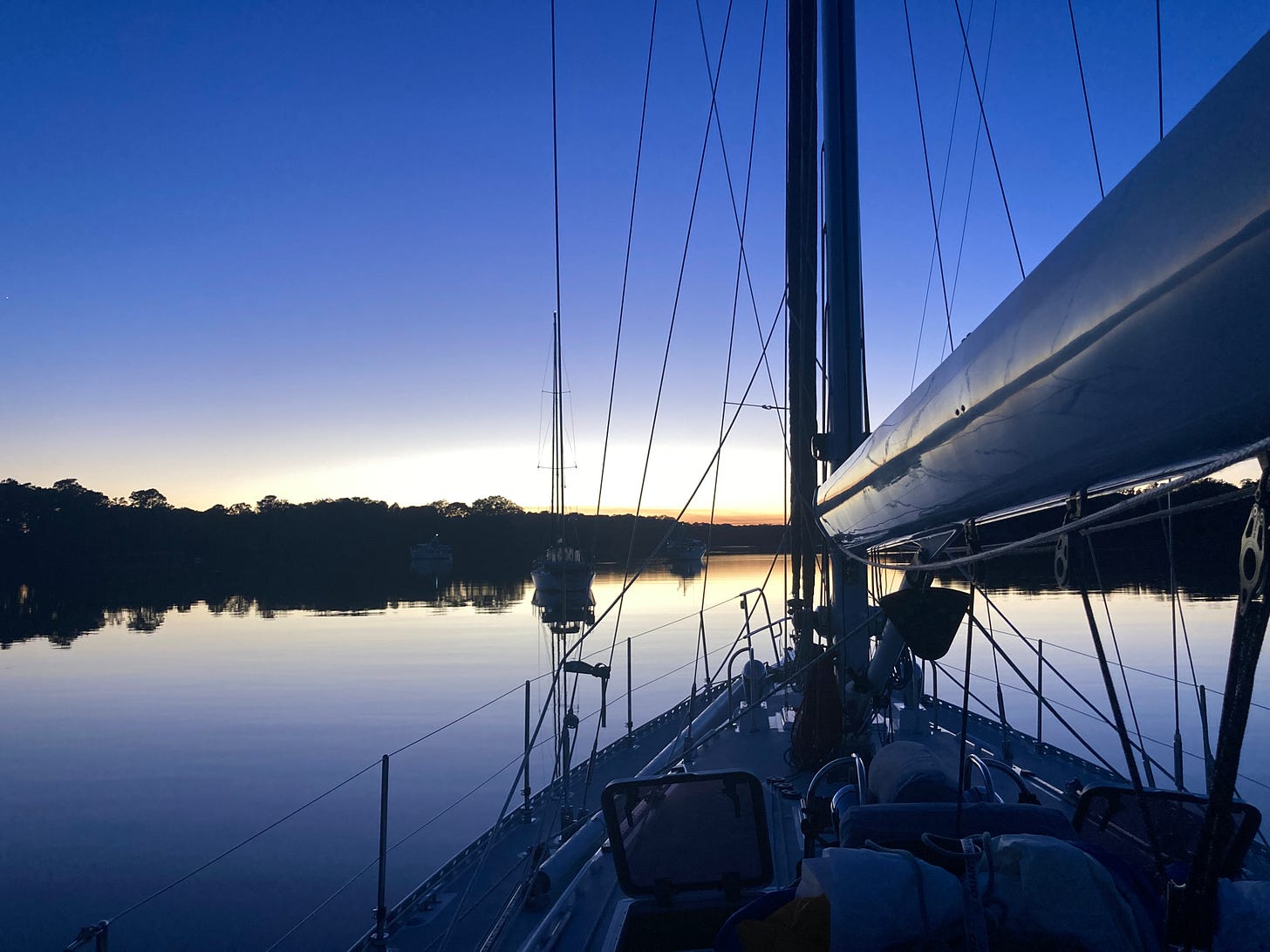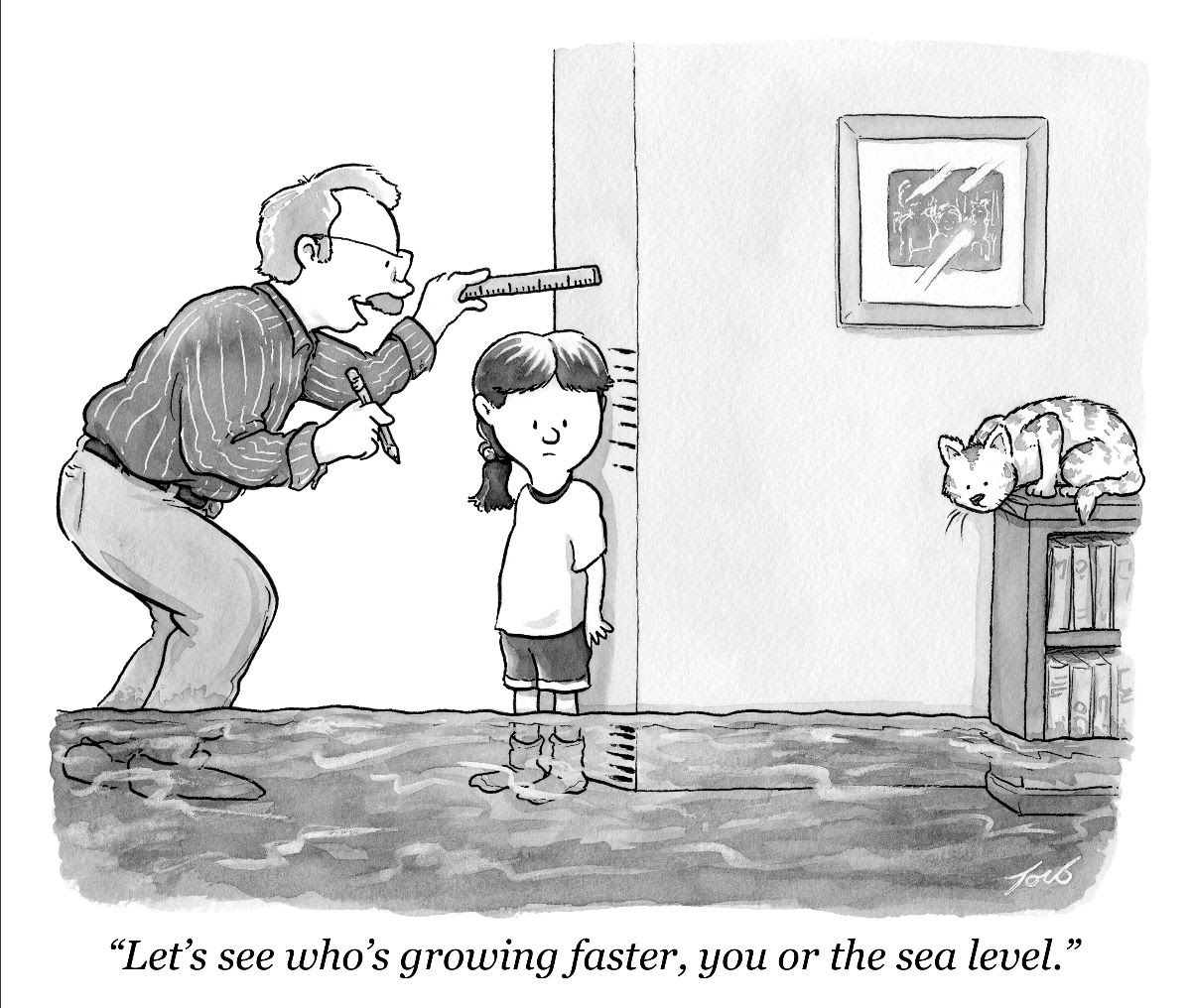I always feel just a tiny bit lost when Laughing Gull is in the yard for maintenance. I love recharging and visiting the world ashore, but I spend enough time on the boat these days that being a terrestrial feels slightly aberrational. A boat needs spa time, and I am always glad to do what it takes to give Laughing Gull what she needs to keep her in good condition and able to perform at her best. Still, I think I can make better sense of the universe when I can hear the slap of water against a hull, feel every little change of temperature and wind, and there is a very long fetch to the horizon.
Even so, moving back aboard takes a brief period of adjustment. Inevitably, I start to revisit all the choices that steered me away from the life I was living. But the peace and beauty of being back on the sea, punctuated by deeply calming sunsets and sunrises, helps restore equilibrium. I’m currently down at the mouth of the Bay, anchored in Mill Creek in Hampton, getting ready to sail to Antigua. LG is in fine shape, and I am slowly working through all small chores required to disappear over the horizon.
The passage south will be the longest so far for me and LG (I’ll sail with three friends aboard), and should take 10-13 days, which is beyond the ken of reliable weather forecasting. The last time I sailed a boat to the Caribbean, in 1998, we sailed with a clear and encouraging forecast, only to be run over by the remnants of Hurricane Mitch, which U-turned unexpectedly in the Gulf Of Mexico, came back east, and smacked us hard.
I hope to not repeat that experience, but November in the south Atlantic is an unstable brew of warm water, spinning low pressure systems, and cold fronts charging off the US east coast. Getting south is like playing Frogger with weather systems. On the plus side, tropical weather forecasting these days is impressively predictive up to about a week. And as long as your crew has some flexibility, it should be possible to minimize the chances of storm drama.
Still, the warming climate is changing and extending hurricane season, so early November is not as reliable a departure window as it used to be. With waters off Florida and in the Gulf Of Mexico at record temperatures, November hurricanes are more possible than ever. Insurance companies, which pay close attention to this changing reality, increasingly decline to insure sailboats heading to the Caribbean from named storms until December 1, which is arguably the new end of hurricane season in a climate-changed world. In fact, I don’t have insurance coverage for a named storm in November, so I need to be extra conservative about heading offshore in the next week or two.
In truth, I think mid-November or after should become the new standard departure window for voyages south, and rallies like the one I am sailing with (Salty Dawgs) should reconsider their schedules to better reflect the climate-fueled extension of the the Atlantic hurricane season. That might be inconvenient for crews that would like to fly home for Thanksgiving, and departure weather might be a bit chillier. But the weather physics of the Atlantic, and the storm gods, don’t care about human desires.
Case in point: any boats looking to jump south are paying close attention to an intensifying discussion among meteorologists regarding the possibility of a late-season hurricane popping up in the western Caribbean next week. That talk is prompted by the US GFS weather model, which looks like this late next week:
The GFS is somewhat lonely in this prediction, but there is general agreement among various models that a low pressure system will spin up in the western Caribbean. The disagreement is over how strong it will become and where it will go. With this sort of uncertainty in play, I am fully plugged into the always fascinating interplay of heat, pressure and moisture which drives weather. I like that deep connection to the natural forces which shape our human experience. But I am always a bit happier when they are not quite as dramatic as the forces that are currently in play.
Beyond always hoping for champagne sailing, I want some lightish off-the-wind sailing at some point so I can finally, after more than two years, play around with the top-down furling spinnaker aboard LG. I have yet to fly it because at first I was lazy, and I was cruising. And then when I stopped being lazy I discovered it was so brutally fouled the last time it was furled it was impossible to open it. It took a sailmaker a few hours of hard work to untangle it all. Now it is ready for action, and with an actual crew on hand for once, there is plenty of manpower to launch, fly and recover it. Everyone says they are tricky to furl (which explains the mess it was in), but this is what it is supposed to look like (Evolution Sails in Hampton sent me this video as they rolled it for me):
I can only hope it goes that smoothly.
Until next week, when I will know our departure fate. In the meantime, root for the Euro over the GFS even if you are not quite sure what that means.
Anthropocene Reading:
Debate all you want about the implications of a second Trump presidency would be for democracy and America, but have no doubt about one thing: It would have a profound and negative impact on efforts to fight and mitigate climate change:
The Republican climate agenda is summarized nicely in Project 2025, the notorious 900-page policy plan developed for Donald Trump by the conservative Heritage Foundation. It proposes gutting the Environmental Protection Agency and its climate regulations; re-opening the Arctic National Wildlife Refuge for drilling; defunding the nationwide transition to renewable energy; and eliminating environmental justice initiatives. In addition, political appointees serving under Trump “will have to eradicate climate change references from absolutely everywhere”—because as we know, ignoring a problem helps fix it. Overall, Project 2025 is a veritable smorgasbord of “burn it all down”—and it aligns squarely with Trump’s own actions and pledges.
Here’s why the US election matters…for the entire planet:
Current climate policies will result in global warming of more than 3 degrees Celsius (5.4 degrees Fahrenheit) by the end of the century, according to a United Nations report on Thursday, more than twice the rise agreed to nearly a decade ago. The annual Emissions Gap report, which takes stock of countries' promises to tackle climate change compared with what is needed, finds the world faces as much as 3.1 C (5.6 F) of warming above pre-industrial levels by 2100 if governments do not take greater action on slashing planet-warming emissions.
Governments in 2015 signed up to the Paris Agreement and a cap of 1.5 C (2.7 F) warming to prevent a cascade of dangerous impacts. "We're teetering on a planetary tight rope," U.N. Secretary General Antonio Guterres said in a speech on Thursday. "Either leaders bridge the emissions gap, or we plunge headlong into climate disaster". Global greenhouse gas emissions rose by 1.3% between 2022 and 2023, to a new high of 57.1 gigatonnes of carbon dioxide equivalent, the report said.
You can’t control America’s voters, but here’s a helpful guide to what you can do in your own life:
The point is not what you shouldn’t do (although there is some of that). It’s about what you should do to exert the most leverage on the global economic system and, hopefully, nudge things toward decarbonization just a little bit faster.
It’s no laughing matter, but…
If you liked this post from Sailing Into The Anthropocene, why not subscribe here (free!), and/or hit that share button below? You can also find me on Instagram and Twitter.









Safe sailing, nephew. If you get to Dominica there are snorkeling tours with curious friendly sperm whales.
Safe sailing, Tim! And that furling spin does look a bit tricky! Hope you get to use it though. Ed